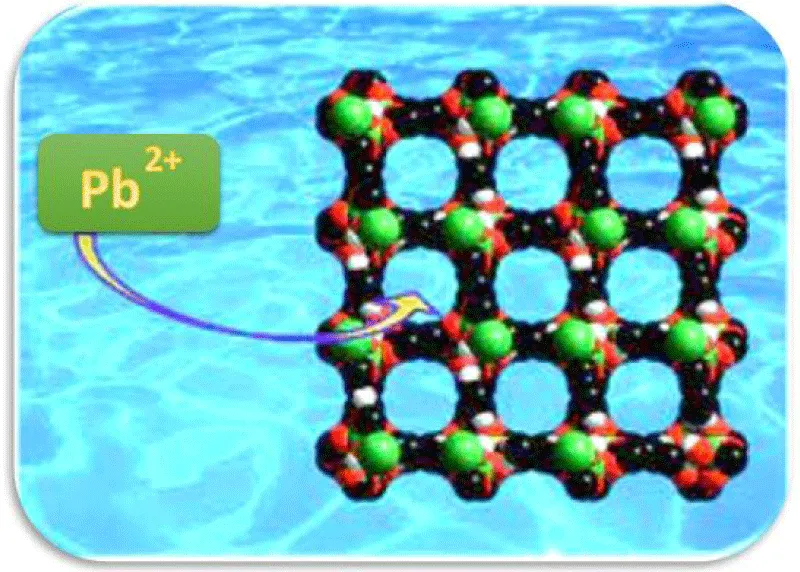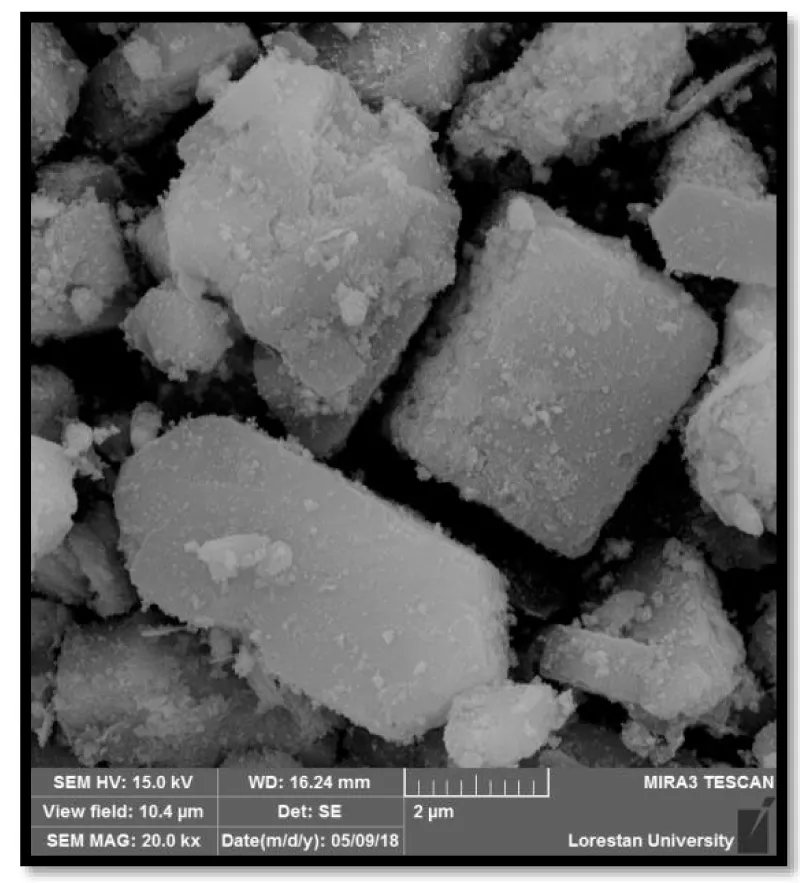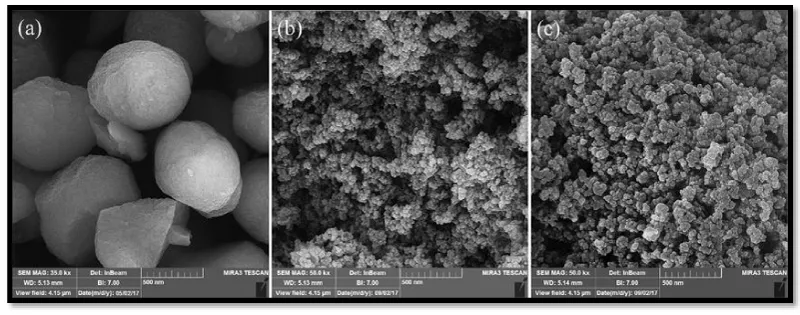Open Journal of Analytical and Bioanalytical Chemistry
Adsorption of Pb2+ ions in aqueous media using the new zeolite nanocomposite adsorbent CaOCdO/ZSM5 synthesized with new techniques
Meysam Sadeghi1 and Pourya Zarshenas2*
2Faculty of Chemistry & Petroleum Sciences, Shahid Beheshti University (SBU), Iran
Cite this as
Sadeghi M, Zarshenas P (2022) Adsorption of Pb2+ ions in aqueous media using the new zeolite nanocomposite adsorbent CaOCdO/ZSM5 synthesized with new techniques. Open J Anal Bioanal Chem 6(1): 001-003. DOI: 10.17352/ojabc.000023Copyright License
© 2022 Sadeghi M, et al. This is an open-access article distributed under the terms of the Creative Commons Attribution License, which permits unrestricted use, distribution, and reproduction in any medium, provided the original author and source are credited.ZSM-5 `is a porous zeolite material that reveals good activity for the adsorption of heavy metals and other contaminants for effluent purification. In this scientific research, we synthesized the novel CaO-CdO/ZSM-5 zeolite nanocomposite adsorbent and studied the effects of different parameters on the adsorption of Pb2+ ions from water media for the first time. About 99.2% adsorption removal efficiency was obtained after a contact time of 60 min and an adsorbent amount of 0.1g/L for an initial Pb2+ concentration of 200mg/L at pH 8 and temperature of 60oC. The adsorption kinetic fit well via the pseudo-second-order model. Furthermore, the adsorption results were reproduced using the Langmuir isotherm with a maximum adsorption capacity of mg/g. The thermodynamic data displayed that the adsorption of Pb2+ ions over the CaO-CdO/ZSM-5 nanocomposite was endothermic and spontaneous.
Graphical abstract Zeolite-based composites for the adsorption of toxic matters from water.
Introduction
Nanocomposite
The nanocomposite is a multiphase solid material where one of the phases has one, two, or three dimensions of less than 100 nanometers (nm) or structures having nano-scale repeat distances between the different phases that make up the material [1].
The idea behind Nanocomposite is to use building blocks with dimensions in nanometre range to design and create new materials with unprecedented flexibility and improvement in their physical properties.
In the broadest sense, this definition can include porous media, colloids, gels, and copolymers, but is more usually taken to mean the solid combination of a bulk matrix and nano-dimensional phase(s) differing in properties due to dissimilarities in structure and chemistry [2].
The mechanical, electrical, thermal, optical, electrochemical, catalytic properties of the nanocomposite will differ markedly from that of the component materials. Size limits for these effects have been proposed.
1. <5 nm for catalytic activity
2. <20 nm for making a hard magnetic material soft
3. <50 nm for refractive index changes
4. <100 nm for achieving superparamagnetism, mechanical strengthening, or restricting matrix dislocation movement [3].
Nanocomposites are found in nature, for example in the structure of the abalone shell and bone [4]. The use of nanoparticle-rich materials long predates the understanding of the physical and chemical nature of these materials. Some researchers investigated the origin of the depth of color and the resistance to acids and bio-corrosion of Maya blue paint, attributing it to a nanoparticle mechanism. From the mid-1950s nanoscale organo-clays have been used to control the flow of polymer solutions (e.g. as paint viscosifiers) or the constitution of gels (e.g. as a thickening substance in cosmetics, keeping the preparations inhomogeneous form). By the 1970s polymer/clay composites were the topic of textbooks, although the term “nanocomposites” was not in common use [5].
In mechanical terms, nanocomposites differ from conventional composite materials due to the exceptionally high surface-to-volume ratio of the reinforcing phase and/or its exceptionally high aspect ratio. The reinforcing material can be made up of particles (e.g. minerals), sheets (e.g. exfoliated clay stacks), or fibers (e.g. carbon nanotubes or electrospun fibers) [6]. The area of the interface between the matrix and reinforcement phase(s) is typically an order of magnitude greater than for conventional composite materials [7]. The matrix material properties are significantly affected in the vicinity of the reinforcement. Some scientists are aware that with polymer nanocomposites, properties related to local chemistry, degree of thermoset cure, polymer chain mobility, polymer chain conformation, degree of polymer chain ordering, or crystallinity can all vary significantly and continuously from the interface with the reinforcement into the bulk of the matrix. This massive quantity of reinforcement surface area means that a relatively small amount of nanoscale reinforcement can have an observable effect on the macro scale properties of the composite [8].
Zeolite
Zeolites are a group of crystalline materials made up of evenly sized pores and tunnel systems. When purifying VOCs and hydrocarbons, we use a synthetic hydrophobic zeolite. When the contaminated air passes through the material, the hydrocarbons are adsorbed. The material can absorb a certain amount of hydrocarbons before needing to be regenerated [9,10].
A smaller flow of hot air is then directed through the material so that the hydrocarbons are released from the zeolite in a higher concentration. This enables more cost-effective incineration. One of its strengths is that it is non-combustible–meaning it can withstand very high temperatures [11]. This means that we are also able to purify volatile hydrocarbons such as fumes emitted from vulcanization, plastic smoke, and styrene, all of which require very high temperatures during regeneration. The resistance to high temperatures and the structure of the material also allows the zeolite to be completely regenerated – meaning that the VOCs completely release from the zeolite when heated. This means that the system maintains its high purification rate year after year and that the material does not have to be replaced, which gives it a long lifespan and a minimal need for maintenance [12]. Our systems have availability of over 99% and a lifespan exceeding 25 years. Combining the benefits of zeolite with our 30 years of experience in working with air purification gives our customers a supremely sustainable and customized system with low operating costs and high availability.
Reversible hydration and dehydration
During drying it comes to the removal of free and bound water from the crystal grid, which is then counterbalanced back in contact with materials such as stored grain and feed, pet litter, in the flue gas to prevent condensation and the like [13]. Clinoptilolite stabilizes moisture at a low dose of volume and avoid the adverse effects of water [14].
Ion exchange
Grid structure allows clinoptilolite to operate as an Ion exchanger and as a selective adsorbent. Adsorption and exchange of ions depend on their charge and size. The more the size of the ion matches the size of the entering grid of clinoptilolite, the easier it will be captured and kept [15]. The entry pore diameter is approximately 4 angstrom, which corresponds to the average ammonium ions NH4+, H2O, 134Cs & 137Cs. These compounds exhibit the greatest affinity to bind to clinoptilolite, which operates as a selective adsorbent for a wide range of pollutants [16].
Result and discussion
FESEM
The morphology and particle size of the as-synthesized CaO-CdO/ZSM-5 by the ultrasonic-assisted hydrothermal method were studied by applying the FESEM analysis. Figures 1,2 illustrates the FESEM image of the CaO-CdO/ZSM-5. From the FESEM image, the hexagonal structure of the ZSM-5 zeolite and the sphere-like shapes of the CaO-CdO NPs were all clearly confirmed. The aforementioned obviously displays the successful fabrication of the CaO-CdO NPs within the ZSM-5 structure without any destructive changes in its crystalline properties. Furthermore, the average length and diameter of the ZSM-5 were achieved to be ~3µm and 2µm, while the CaO-CdO NRs was determined to be 15nm, respectively.
Conclusion
The present research was aimed to investigate the adsorption of Pb2+ ions from water media on the CaO-CdO/ZSM-5 zeolite nanocomposite. The outcomes illustrated that 0.1g/L of CaO-CdO/ZSM-5, pH 8, initial Pb2+ concentration of 200mg/L, and contact time of 60 min were optimized for maximum adsorption of Pb2+ ions. The kinetic evaluation displayed that the adsorption of Pb2+ ions on the CaO-CdO/ZSM-5 nanocomposite follows the pseudo-second-order model. Also, this study follows the Langmuir isotherm with a qmax amount of 125.7mg/g. Furthermore, the thermodynamic data demonstrated that the adsorption of Pb2+ ions on the CaO-CdO/ZSM-5 nanocomposite was endothermic and spontaneous in nature. Additionally, CaO-CdO/ZSM-5 adsorbent was regenerated up to 4 runs revealing its suitability to be used repeatedly in Pb2+ adsorption.
- Song Y, Chen Y, Xu M, Wei W, Zhang Y, Yang G, et al. (2020) A Cobalt‐Free Multi‐Phase Nanocomposite as Near‐Ideal Cathode of Intermediate‐Temperature Solid Oxide Fuel Cells Developed by Smart Self‐Assembly. Adv Mat 32: 1906979. Link: https://bit.ly/3HvVwL6
- Rane AV, Kanny K, Abitha VK, Thomas S (2018) Methods for synthesis of nanoparticles and fabrication of nanocomposites. In S. M. Bhagyaraj, O. S. Oluwafemi & S. Thomas (Eds.), Synthesis Inorganic Nanomaterials. Woodhead Publishing 121-139. Link: https://bit.ly/3umn7L2
- Lopez N, Janssens TVW, Clausen BS, Xu Y, Mavrikakis M, et al. (2004) On the origin of the catalytic activity of gold nanoparticles for low-temperature CO oxidation. J Catal 223: 232-235. Link: https://bit.ly/3B0rNYb
- Hubbe MA, Rojas OJ, Lucia LA, Sain M (2008) Cellulosic nanocomposites: a review. BioResources 3: 929-980. Link: https://bit.ly/34bEIe6
- Kornmann X, Lindberg H, Berglund LA (2001) Synthesis of epoxy–clay nanocomposites: influence of the nature of the clay on structure. Polymer 42: 1303-1310. Link: https://bit.ly/3un5CKD
- Fornes TD, Paul DR (2003) Modeling properties of nylon 6/clay nanocomposites using composite theories. Polymer 44: 4993-5013. Link: https://bit.ly/32Vydv5
- Wagner HD, Lourie O, Feldman Y, Tenne R (1998) Stress-induced fragmentation of multiwall carbon nanotubes in a polymer matrix. Appl Phys Lett 72: 188-190. Link: https://bit.ly/3rnUQlq
- Gu D, Meng G, Li C, Meiners W, Poprawe R (2012) Selective laser melting of TiC/Ti bulk nanocomposites: Influence of nanoscale reinforcement. Scr Mater 67: 185-188. Link: https://bit.ly/3oKi0kn
- Ioana F, Wang Y, Védrine JC (2012) The past, present and future of heterogeneous catalysis. Catal Today 189: 2-27. Link: https://bit.ly/3HqJrqs
- Dąbrowski A (2001) Adsorption—from theory to practice. Adv Colloid Interface Sci 93: 135-224. Link: https://bit.ly/3LaQ7LC
- Shahabuddin M, Alam T, Krishna BB, Bhaskar T, Perkins G (2020) A review on the production of renewable aviation fuels from the gasification of biomass and residual wastes. Bioresour Technol 312: 123596. Link: https://bit.ly/35O8rdr
- Khan FI, Ghoshal A (2000) Removal of volatile organic compounds from polluted air. J Loss Prev Process Ind 13: 527-545. Link: https://bit.ly/3shC7Hf
- William LR, Murphy C (2001) Rubbish!: the archaeology of garbage. University of Arizona Press 263. Link: https://bit.ly/3HrYG2B
- Christopher G, Johnston D, Pritchard M (2012) A dictionary of construction, surveying, and civil Engineering. Oxford University Press. Link: https://bit.ly/3oqwUfn
- Malamis S, Katsou E (2013) A review on zinc and nickel adsorption on natural and modified zeolite, bentonite and vermiculite: examination of process parameters, kinetics and isotherms. J Hazard Mater 252: 428-461. Link: https://bit.ly/34AoISI
- Ruren X, Pang W, Xu J, Huo Q, Chen J (2009) Chemistry of zeolites and related porous materials: synthesis and structure. John Wiley & Sons.

Article Alerts
Subscribe to our articles alerts and stay tuned.
 This work is licensed under a Creative Commons Attribution 4.0 International License.
This work is licensed under a Creative Commons Attribution 4.0 International License.



 Save to Mendeley
Save to Mendeley
